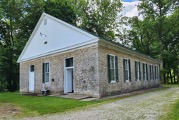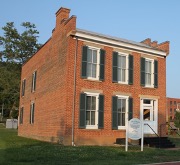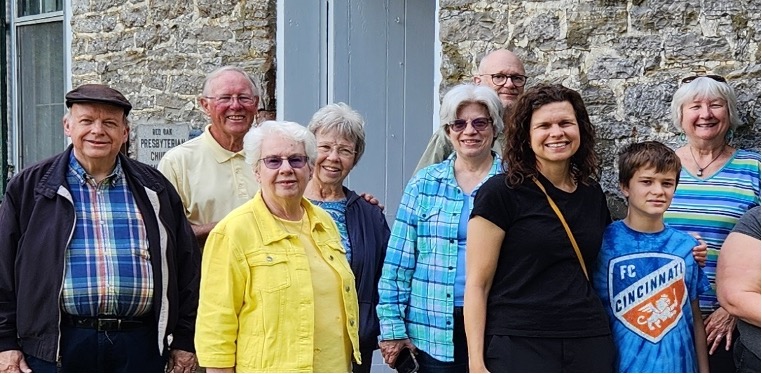Through the work of the Heritage Church Social Justice Collaborative, on Saturday, May 18, 2024, thirteen Heritage people went on a field trip to Ripley, Ohio, to visit three “stations” of the Underground Railroad. In the 1800s, Ripley, along with Cincinnati and Philadelphia, were the top three most active hubs of the Underground Railroad that moved escaped enslaved people to freedom. The next three most active hubs were also river towns: Louisville, St. Louis, and Cairo, Illinois.

Red Oak Presbyterian Church building
Red Oak Presbyterian Church was founded in 1798. Rev. James Gilliland and his wife, who were disgusted with what they saw of slavery and believed fervently that it was against God’s will, came to Red Oak in 1804, having heard about the work already being done there.
In the South the minister’s sister-in-law had started teaching Black children to read, and for it the family was driven out of town on threat of death. They joined the Gillilands to help with the work. At the time of the founding of Red Oak, the congregation included both Blacks and whites. An integrated school was started next to the church a year later.

Red Oak Presbyterian Church plaques
When an escaping enslaved person came to the church, the women gave them biscuits and doughnuts they had cooked, for nourishment along the way. A man would accompany the person or persons to the next Underground Railway station. Well over a thousand escapees made their way through Red Oak Presbyterian Church as part of the Underground Railroad.

Rankin House
Rev. John Rankin and his family moved to Ripley in the early 1800s, to become pastor of the Ripley Presbyterian Church, which had been founded by people from Red Oak Presbyterian.

Rankin House Plaque
Though many in the town helped the anti-slavery movement, others were against it. Rev. Rankin and his family members were often accosted verbally and physically. He bought land and built his house on a hill in 1828, and it soon became a major station on the Underground Railroad.

Rankin House View
One of the things the Rankins did was provide an escaped person with a new set of clothes, so that they were no longer dressed in the manner of slaves. Many people in the Ripley area were involved in producing clothing and shoes for this purpose.

Rankin house window and lamp
Under both Federal and state law, it was illegal to help fugitive slaves to freedom. Bounty hunters were always a threat to the people who worked the Underground Railroad. The Rankins ate every meal with the sons holding guns, standing guard, looking from the house.

Rankin house docent and Heritage tour group
Not only Rev. Rankin, but over time each of his sons, took up the job of accompanying an escaped person to the next station on the Underground Railroad. If any of the Rankins had been caught while accompanying a formerly enslaved person, they would have been, at best, taken to a Southern state and put in jail, and at worst, shot on the spot by a bounty hunter.

Parker house
John Parker was born into slavery. At a young age, he taught himself to read, using books that the plantation owner’s young sons shared with him. After Parker attempted to escape several times, and after he had been sold to a new household, he made an arrangement with the mistress of the house, allowing him to buy his freedom with money he earned by working incredible overtime on the piecework production where he was hired out. After he married in Cincinnati, he came to Ripley. Parker designed and built his house in downtown Ripley in 1853. John Parker acted not only as a station on the Underground Railroad, but as an extractor, doing the dangerous work of going into slave states and accompanying people as they fled north.
Many in Ripley supported the Underground Railroad, and it was common to see someone carrying a big pot of beans from one house to another, ostensibly for the residents of the house but really to feed the escapees. Decades later, former enslaved persons who had passed through Ripley said that the number one thing they remembered was the hospitality that was shown to them there.
Over the years, John Parker worked in a foundry and a metal workshop, and then built, owned and ran several of these. He was also an inventor, having several patents in his name. Parker and his wife believed strongly in education: Five of his seven children earned college degrees, with the other two becoming music teachers.
There are no confirmed photographs of John Parker known to exist; he said he did not want his photograph taken just to make sure it didn’t end up on a “Wanted” poster.
After the Heritage Church visit to these three sites, all members of the group noted how much they had learned during the trip.
Image Credits: Top image of group of people from Heritage: Photo from Rae Jane Araujo, taken by Red Oak Presbyterian Church member. Red Oak Presbyterian Church building: Photo by Russ Araujo. Historical plaques at the Red Oak Presbyterian Church: Photo by Russ Araujo. John Rankin House: Photo by J. Stephen Conn, Creative Commons license. Historical plaque at the John Rankin House: Photo by Rebecca Pace. Rankin House view of the Ohio River: Photo by Rebecca Pace. Rankin House window and lamp: Photo by Rae Jane Araujo from a prior visit. Rankin House docent and Heritage group: Photo by Rebecca Pace. John Parker House, Ripley, Ohio: Photo by Joseph, Creative Commons License.

